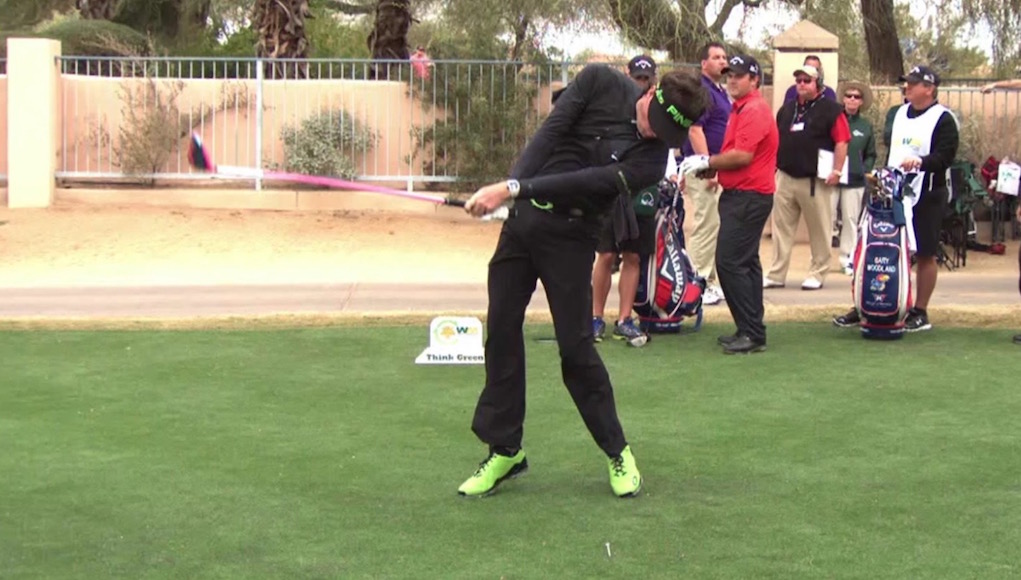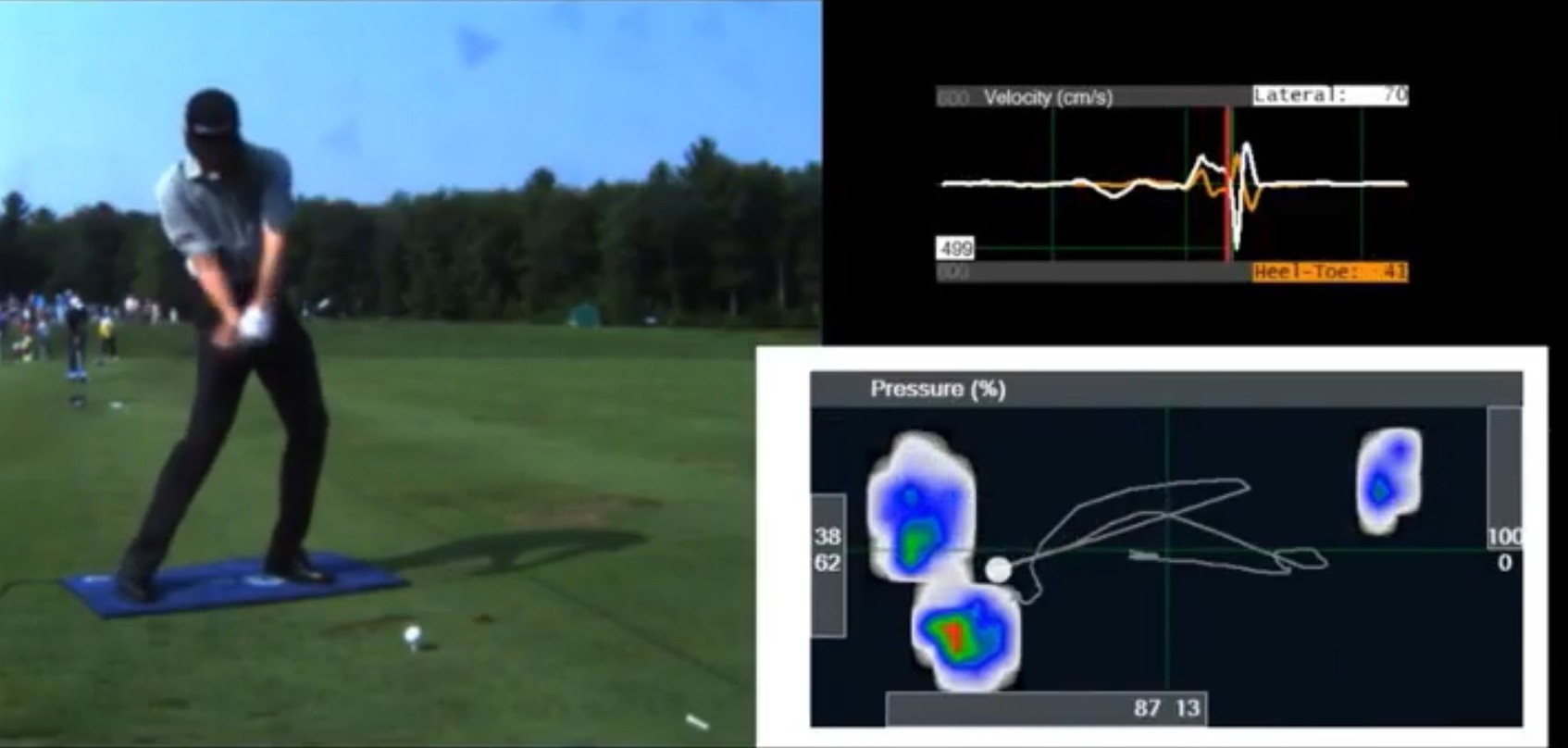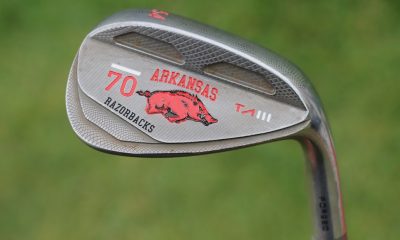Instruction
Using pressure mats to understand vertical ground forces in the golf swing

I’m a golf nerd. I think that’s pretty obvious based on my previous GolfWRX Instruction Articles. I love how new technologies measure and break down the mechanics of a golf swing, and being able to share these discoveries with all of you is one of my favorite parts of writing for GolfWRX.
I have been using the BodiTrak Pressure Mat System now for well over a year, and have been fortunate to measure some of the most elite players in the world, including several PGA and LPGA tour players. I absolutely love how my BodiTrak allows me to understand how a golfer’s feet interact with the ground, and as I’ve learned, ground interaction has a huge effect on the way a golfer delivers a golf club into impact.
That being said, there was one measurement I used to think pressure mats had limitations measuring: vertical forces. I’ve come to recognize, however, that pressure mats can effectively measure vertical forces. While pressure mats do not measure vertical forces the same way as force plates, they do provide us with the knowledge we need to observe and improve vertical force patterns.
Vertical forces are measured three different ways with a pressure mat system. First, they measure the relationship of how hard your feet press downward into the ground. The amount of pressure is shown as a color-coded graph over a golfer’s feet. So while there are no exact measurements, the colors do measure trends which are defined as follows:
- Light Blue: The lightest pressure being applied to the ground.
- Blue: The second-lightest pressure being applied to the ground.
- Green: The third-lightest pressure being applied to the ground.
- Red: The hardest pressure being applied to the ground.
The second way vertical forces are measured with a pressure mat system is through the action of the Center of Pressure (COP). When the COP is moving toward the target, the measurement is positive. When the COP is moving away from the target, the measurement is negative. If you pick up one of your feet, your COP moves directly to the foot that is still on the ground.
So how does all this help us measure vertical forces? The information, when slowed down without a golf club in your hands, helps us understand how our feet produce the upward, vertical forces during the two-second explosion of the golf swing. Please view the following video for more details.
We see BodiTrak’s identification of the upward vertical forces magnified by power players and/or players hitting their drivers. Two COP traces (the visual, historical measurement of where the COP moves during the golf swing) identify this trait:
- The Power Trace
- The Power-Z Trace
The biggest difference between the two traces, with relation to upward vertical forces, is just how much a player unweights their lead side during the downswing sequence.
James Hahn (Power Trace)
Power Tracers unweight their lead leg, but most of the time the lead leg looks to stays more connected to the ground when observed on video. To see examples of some Power Tracers measured by BodiTrak, you can watch the swings and traces of two-time PGA Tour winner James Hahn (above), as well as Luke List (below), who was 7th in Driving Distance on the PGA Tour in 2016.
Luke List (Power Trace)
Power-Z Tracers unweight their lead side more than a Power Tracer, and are frequently seen getting their lead side off the ground on video. Both unweighting sequences makes the COP shift away from the target and back toward the trail foot.
Jimmy Walker (Power-Z Trace)
Some Power-Z tracers get so vertical that their lead leg actually leaves the ground. Think Bubba Watson, Jamie Sadlowski and Lexi Thomson. BodiTrak has measured Power-Z Tracers Jimmy Walker, the 2016 PGA Championship winner, as well as Nicolas Colsaerts, who was third in Driving Distance on the European Tour in 2016.
Nicolas Colsaerts (Power-Z Trace)
How vertical, or how hard a player vertically pressed off the ground to get airborne, determines how far and fast the COP moves toward the trail foot. This is the third way that pressure mats measure vertical forces.
Two Power-Z Traces Measured and Quantified with BodiTrak
If you’re curious about how you are using vertical forces in the golf swing, it would be worth your while to get a lesson from an instructor with a pressure mat system.
Good luck!
- LIKE38
- LEGIT5
- WOW2
- LOL4
- IDHT0
- FLOP1
- OB1
- SHANK25
Instruction
Clement: Laid-off or perfect fade? Across-the-line or perfect draw?

Some call the image on the left laid off, but if you are hitting a fade, this could be a perfect backswing for it! Same for across the line for a draw! Stop racking your brain with perceived mistakes and simply match backswing to shot shape!
- LIKE1
- LEGIT0
- WOW0
- LOL0
- IDHT0
- FLOP0
- OB0
- SHANK1
Instruction
The Wedge Guy: The easiest-to-learn golf basic

My golf learning began with this simple fact – if you don’t have a fundamentally sound hold on the golf club, it is practically impossible for your body to execute a fundamentally sound golf swing. I’m still a big believer that the golf swing is much easier to execute if you begin with the proper hold on the club.
As you might imagine, I come into contact with hundreds of golfers of all skill levels. And it is very rare to see a good player with a bad hold on the golf club. There are some exceptions, for sure, but they are very few and very far between, and they typically have beat so many balls with their poor grip that they’ve found a way to work around it.
The reality of biophysics is that the body moves only in certain ways – and the particulars of the way you hold the golf club can totally prevent a sound swing motion that allows the club to release properly through the impact zone. The wonderful thing is that anyone can learn how to put a fundamentally sound hold on the golf club, and you can practice it anywhere your hands are not otherwise engaged, like watching TV or just sitting and relaxing.
Whether you prefer an overlap, interlock or full-finger (not baseball!) grip on the club, the same fundamentals apply. Here are the major grip faults I see most often, in the order of the frequency:
Mis-aligned hands
By this I mean that the palms of the two hands are not parallel to each other. Too many golfers have a weak left hand and strong right, or vice versa. The easiest way to learn how to hold the club with your palms aligned properly is to grip a plain wooden ruler or yardstick. It forces the hands to align properly and shows you how that feels. If you grip and re-grip a yardstick several times, then grip a club, you’ll see that the learning curve is almost immediate.
The position of the grip in the upper/left hand
I also observe many golfers who have the butt of the grip too far into the heel pad of the upper hand (the left hand for right-handed players). It’s amazing how much easier it is to release the club through the ball if even 1/4-1/2″ of the butt is beyond the left heel pad. Try this yourself to see what I mean. Swing the club freely with just your left hand and notice the difference in its release from when you hold it at the end of the grip, versus gripping down even a half inch.
To help you really understand how this works, go to the range and hit shots with your five-iron gripped down a full inch to make the club the same length as your seven-iron. You will probably see an amazing shot shape difference, and likely not see as much distance loss as you would expect.
Too much lower (right) hand on the club
It seems like almost all golfers of 8-10 handicap or higher have the club too far into the palm of the lower hand, because that feels “good” if you are trying to control the path of the clubhead to the ball. But the golf swing is not an effort to hit at the ball – it is a swing of the club. The proper hold on the club has the grip underneath the pad at the base of the fingers. This will likely feel “weak” to you — like you cannot control the club like that. EXACTLY. You should not be trying to control the club with your lower/master hand.
Gripping too tightly
Nearly all golfers hold the club too tightly, which tenses up the forearms and prevents a proper release of the club through impact. In order for the club to move back and through properly, you must feel that the club is controlled by the last three fingers of the upper hand, and the middle two fingers of the lower hand. If you engage your thumbs and forefingers in “holding” the club, the result will almost always be a grip that is too tight. Try this for yourself. Hold the club in your upper hand only, and squeeze firmly with just the last three fingers, with the forefinger and thumb off the club entirely. You have good control, but your forearms are not tense. Then begin to squeeze down with your thumb and forefinger and observe the tensing of the entire forearm. This is the way we are made, so the key to preventing tenseness in the arms is to hold the club very lightly with the “pinchers” — the thumbs and forefingers.
So, those are what I believe are the four fundamentals of a good grip. Anyone can learn them in their home or office very quickly. There is no easier way to improve your ball striking consistency and add distance than giving more attention to the way you hold the golf club.
More from the Wedge Guy
- The Wedge Guy: Golf mastery begins with your wedge game
- The Wedge Guy: Why golf is 20 times harder than brain surgery
- The Wedge Guy: Musings on the golf ball rollback
- LIKE88
- LEGIT15
- WOW6
- LOL1
- IDHT0
- FLOP4
- OB1
- SHANK9
Instruction
Clement: Stop ripping off your swing with this drill!

Not the dreaded headcover under the armpit drill! As if your body is defective and can’t function by itself! Have you seen how incredible the human machine is with all the incredible feats of agility all kinds of athletes are accomplishing? You think your body is so defective (the good Lord is laughing his head off at you) that it needs a headcover tucked under the armpit so you can swing like T-Rex?
- LIKE0
- LEGIT3
- WOW2
- LOL0
- IDHT0
- FLOP0
- OB0
- SHANK2
-

 19th Hole3 weeks ago
19th Hole3 weeks agoLET pro gives detailed financial breakdown of first week on tour…and the net result may shock you
-

 19th Hole1 week ago
19th Hole1 week agoReport: LIV star turns down PGA Championship invite due to ‘personal commitments’
-

 19th Hole2 weeks ago
19th Hole2 weeks agoGary Player claims this is what ‘completely ruined’ Tiger Woods’ career
-

 Equipment1 week ago
Equipment1 week agoDetails on Justin Thomas’ driver switch at the Wells Fargo Championship
-

 Whats in the Bag2 weeks ago
Whats in the Bag2 weeks agoTeam McIlowry (Rory McIlroy, Shane Lowry) winning WITBs: 2024 Zurich Classic
-

 Whats in the Bag1 week ago
Whats in the Bag1 week agoKeegan Bradley WITB 2024 (May)
-

 Equipment2 weeks ago
Equipment2 weeks agoGolf fans left surprised by LIV’s choice of course for its 2024 individual championship event
-

 Whats in the Bag3 days ago
Whats in the Bag3 days agoRory McIlroy’s winning WITB: 2024 Wells Fargo Championship






















GJ
Jan 4, 2017 at 3:10 am
Also depends on what sort of ball flight (left/right, high/low etc) is being applied, which is not discussed here. Same guy hitting a fade in one shot and a draw in another will look completely different.
Kyle Coultas
Jan 3, 2017 at 8:43 pm
Curious to see what pressure mats would indicate on IMPACT testing, rather than footwork in the golf swing. I’m off balance and forward every strike, like a Gary Player or Bubba, but impact is always different with every situation. I’d like to see stock swings and how they interact with the turf.
Ccshop
Jan 3, 2017 at 1:00 pm
Sorry, wrong about Jimmy Walker. All the extra movement from the swing happens after impact. When tracing on boditrak you take top of swing, vertical and impact. When you look at Walkers swing, it would be a fish hook trace which is what you call a power trace.
Jon
Jan 3, 2017 at 12:44 pm
Save yourself a couple of bucks and just go buy a Wii Fit.